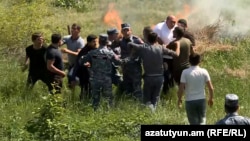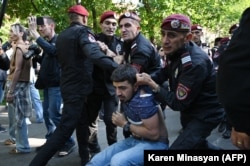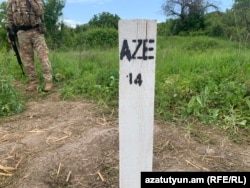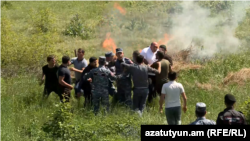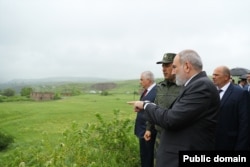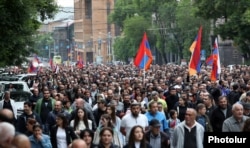YEREVAN -- Protests were seen throughout Yerevan on May 27 as demonstrators blocked traffic as part of a planned civil disobedience campaign aimed at putting pressure on Armenia’s Prime Minister Nikol Pashinian. More than 270 people have been detained at demonstrations across the Armenian capital.
The Yerevan protests were called by the Tavush For The Homeland movement, which opposes recent border demarcations in Armenia’s northern Tavush region that follow a series of military defeats to Azerbaijan under Pashinian.
The recent delimitation of the border in the north of Armenia saw Azerbaijan regain jurisdiction over four villages that had been under Yerevan’s control since the first Armenian-Azerbaijani war in the early 1990s. Local residents say in some cases border markers were emplaced after dark.
In the village of Kirants, the demarcation led to scuffles between police and local residents, some of whom demolished buildings that are due to be handed to Azerbaijan.
Border guards are being moved into the area, replacing the military forces that Armenia and Azerbaijan had stationed there for decades.
The new boundary line was based on Soviet-era maps. In Kirants, the delimitation cedes 50 plots of land and two residential homes to Baku. It has not been announced when the Kirants villagers will be made to leave their homes. Yerevan has vowed to compensate evicted locals with either money or property.
The border delimitation began on April 19 and finished on May 15, when the deputy prime ministers of Armenia and Azerbaijan met to formalize the end of the process. No images of the meeting were released.
Growing unease at the land concessions to Baku has been harnessed by Bagrat Galstanian, an archbishop from Tavush Province who has drawn huge numbers of protesters in recent days. Galstanian has repeatedly called for Pashinian to resign over what many view as excessive yielding to Baku.
Pashinian has said the land concessions in the north of Armenia will serve as a major step toward peace with Azerbaijan. "We are not drawing a new border, we are simply reproducing the de jure border that had legal authority at the time of the collapse of the Soviet Union," he told RFE/RL's Armenian Service.
